Thankfully saved from steampunkers

[Chris] found a really cool pocket watch-style multimeter in a box of junk that was passed down from father to son. There aren’t any markings on it, so he’s looking for any information he can get on it. It’s a cool piece of vintage tech in any occasion; check out the pics he sent in below:
Here’s a fix for your illegal stuff

[Don] ‘acquired’ one of those China-only Raspberry Pis, but after plugging it in, only the power light would stay on. The fix, apparently, is putting these three files in the /boot folder of a Red Pi SD card.
Not a pocket watch
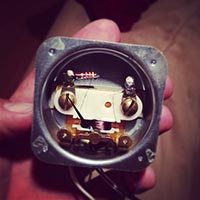
[Tom] picked up an old DC volt meter in an antiques shop. He quickly gutted it to make an analog meter display for his Raspberry Pi. There’s a few status lights to remind [Tom] of something he hasn’t figured out yet. Bonus points for a cheap buck boost converter, though.
Smashing monitors? Really?

The Meriden, CT hackerspace, the New England Society of Information and Technology, was vandalized last week. They’re dealing with some real punks here; their computers weren’t stolen, they were just smashed. NESIT is looking for donations (both money and equipment), so if you have a few monitors or old boxxen and live around there, consider donating them.
Help a guy out here.

[Jonathan] is a real cool dude that’s working on his master’s thesis on ways to build a sustainable company through the development of open source hardware. He wants you to take a survey. How do we know he’s cool? He had something posted on HaD back when we had the old black and white and scotch tape images.

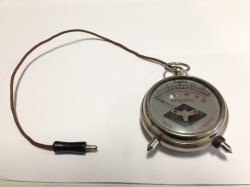
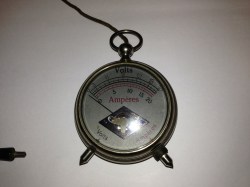
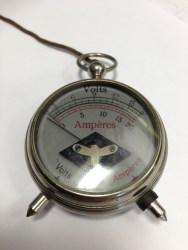
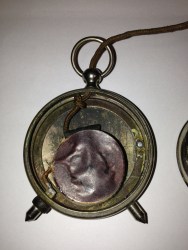














I have voltmeter envy.
google –> eldredge meter
that should get it going. ;)
This meter was used to test batteries and cells in early cars and car radio uses
I remember seeing one just like that at my Dad’s garage back around 1960.
I’ve seen a few different styles of these and actually had one I acquired in the UK back in the 1960’s, somewhat larger and more cylindrical. It was old then so I assume these were popular for automotive electrical use back in the 40’s. Mine had a small red push button that changed the voltage range from 1-10V to 0-20V which would tend to place it when 6V car electrics were the most common.
Oh damn, I remember my grandfather testing batteries with one that looked like that.
I remember seeing one in an Adafruit post a few years ago.
http://www.adafruit.com/forums/viewtopic.php?f=8&p=68289
Has a nice picture of the inside of one if that helps.
KG
[Tom] didn’t need a buck-converter. Just remove the shunt resistor from the meter (you can even see it in the photo) to drop the range. Should give you something that works well (and very easily) with a transistor driver and 3 – 5V.
Also, [Tom] should do some more research on VU meters:
“..Timball reminded me that VU meters are basically just galvos, and use resistors to set their range.”
C’mon guys, do some research! This couldn’t be any further from the truth. There are ‘cheap’ (i.e. for display only) meters that most likely do this, but the originals used a full-wave rectifier as a ‘peak averaging’ filter. ;)
I hope they are caught. Some kids did the same to a local school here, but luckily they were stupid enough to upload it to twitter using an iphone containing gps exif data and using the data connection of the phone so they got caught (the next day even, police in belgium normally is slow, but this was likely very easy.).
Sadly they could not pay and their parents also had no money (but apparently they had an iphone), but at least they are now working a long time to pay it back.
For the school it would maybe have been better if they were not caught, they would have gotten the money instantly from the property insurance, now they get it in monthly parts from debt management.
TLDR: Wearning an anonymous mask does not help if you have a tracking device in your pocket.
Well, I don’t get it why they make China-Only RasPi without CE and FCC marks. Is there some per-unit cost? I thought you get certificate of conformity and it’s one-time expense.
I think because the Chinese ones are being made in a different factory, they’ve licensed the design to them (Egoman). Each factory would need it’s own CE / FCC stamp right? And since it’s for the Chinese market, they needn’t bother.
If they did get them FCC’d, they might well be considered in competition with the existing Western Raspberry Pi people, who wouldn’t appreciate it.
As far as I understand it, it is just that Farnell and RS has an exclusive license to manufacture the raspberrypi, but they’ve made an agreement that else can manufacture and sell their own version as long as they keep it in china
Making it red makes it easily recognizable and omitting the the CE/FCC marks
prevents is from being sold legally in the rest of the world
think DVD regional codes for hardware
I have an old Westinghouse “moving vane” voltage meter.
The scale reads 0-5 volts, but 5 volts only reads about half scale.
If I’m not mistaken, the left-hand terminal “prod” of the voltmeter is connected to the metal case! Good thing it’s for voltages up to 15V only. Not very safe, though. I’m glad that it’s been passed down in the family — my father had one that was my grandfather’s, but I don’t know what happened to it. My grandfather was an engineer who did electrical installations, probably in about 1910-1930.
Yes it is John, I have tried the meter with 5V and 12V and thankfully it still works, it is around a Volt out tho.
I have a desktop and 2 printers i would be happy to donate but i live in NC i would really like to help though. O called the phone number and didn’t get an answer so i guess ill call back later
i fully support raspi because of there cause but for the ripoff PIs how much do they cost? do they use the same baudcom chip? i was told there really hard to obtain!
I have a similar meter, tho not as nice. Mine is branded Sterling, made in Cleveland, and on the back it says pat’d oct 3, 1916.
http://i99.photobucket.com/albums/l295/hozay_2006/2013-03-12110129_zpsd41643c5.jpg
I read some computers have been stolen. A good idea is to install something that calls home (and allows remote access). If the guy that stole it uses it you can likely find some info. This cannot be used as evidence in itself, but will help the police by telling them where to look.
Some company laptops were stolen and some guy typed his home address on them. The police went to the location, and the guy now owning the computer showed the online auction where he bought it, leading to arrest of the thief.
It is likely not enough for a warrant, but if the system was sold to someone else he will probably tell where he bought it even without a warrant if asked about the new computer.
In case the computer is sold to someone else it can also help to make a screen appear saying ‘This computer has been stolen. Please contact the police for assistance.’.
Another option I have heard about is a program that erases the flash memory on the motherboard, making it unbootable, in the hope that the user will bring the computer to a store. When the system is booted and detects a new mac address (due to the new motherboard) a popup indicating that the system is stolen is shown. This was an in-house solution made by a company IT guy, but I can see it working.
you talking about the PI?
no one said they were stolen its common for china to make ripoffs and sell them here
No not the Pi, they are made under license. If you are going to order an embedded linux board in china order the cubieboard, it’s faster than the Pi, has more and better GPIO, has real ethernet instead of via USB, almost same price (little lower/higher, depends on supply and demand) and the GPU is mostly open (enough to run own dsp code).
I was talking about the computers in the hackerspace: ‘we had 2 machines @ the space that had decent nvidia cards that we used to have mining last year until the power consumption was more than the cost of bitcoin, we unfortunately brought them back the week this happened to start mining again. One of the machines was vandalized, they opened the machine poured chemicals into the card itself and the motherboard, when the power was restored it shorted it all out; the other machine they stole.’
(Source: reddit)
I bought a couple of them in an electronic flee market in DeAnza college (Cupertino, CA). They are gorgeous…And for $3 each it was a bargain.
cool multimeter but to be honest i dont know how safe i would feel measuring 20 amps with that thing……
I am a Steampunk not a steampunker:) there is a huge difference in that a true steampunk would not ruin, destroy or re-design an already working device of beauty like this however steampunkers or Chipmunk Steampunks would.
I collects vintage electroshock therapy devices and all of them have been restored to only to the point where they are functional, If they are beyond that then they do get turned in to something creative and i’m not talking about gluing some gears on it and calling it steampunk as seems to be the case in the commercial world.
It pains me to see how many unique devices are scrapped in the name of Steampunk and are used to make static do nothing things.
I’m also a Steampunk, and I too would never destroy an actual antique item in the name of steampunk. Actually that would be pretty much frowned upon by most of the Steampunk community. People who scrap stuff in the name of Steampunk, generally are not part of the Steampunk community, or tend to be trying to cash-in on a “cool trend” they found on the interwebynets… If it’s been rolled in “cog glitter” and stuck on Etsy with a silly price, then it’s not the work of an actual Steampunk.
It has been my observation that Steampunks prefer to keep old items for what they are, rather than destroy them. Already broken items of no further use or repair are fair game though. Better to be reused than end up in landfill somewhere.
OMG! That would look AMAZING on my steam punk costume!
Hi guys, thanks for the replies with other watch-style multimeters, nice to see some others. I still haven’t been able to get any information on specifically my meter, I would love to know where and when it was made.
The Beede Corporation (still operating in New Hampshire) also made meters of this style during the same period. I have one example among my meters, and despite some wear & tear (cracked insulation on wire probe, cracked bezel) it functions just as it did when it was made. It’s neat to see mention of this style of meter after so many years!